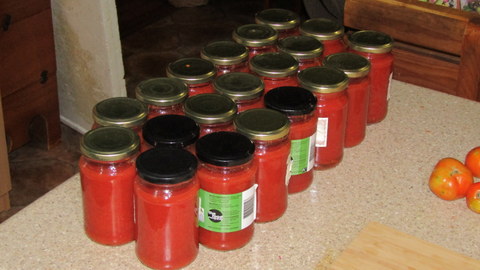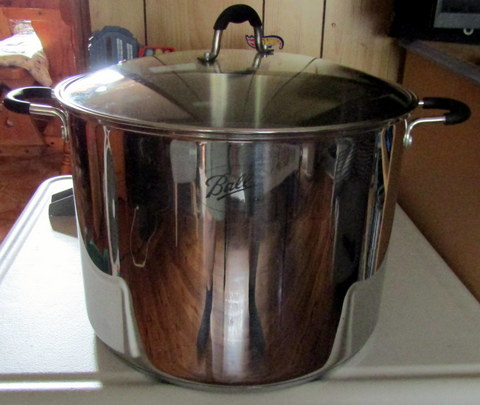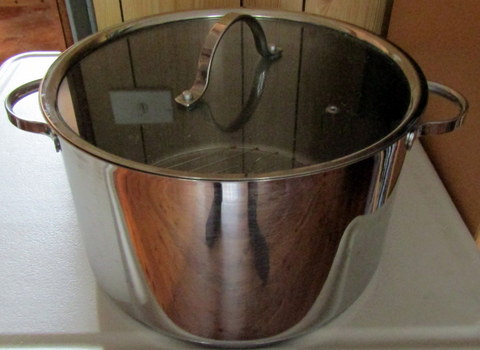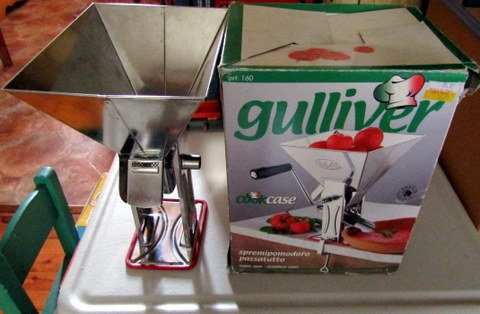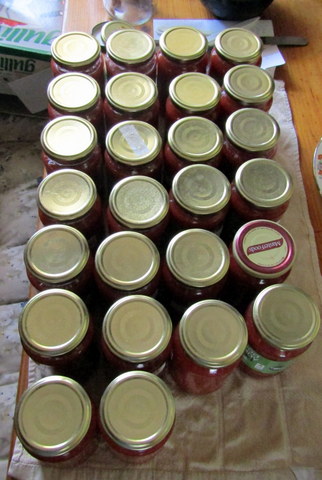Every year we make a load of pasta sauce the traditional away and diced tomatoes the easy way, usually around 50 jars of each, enough to last us a year and since I wrote the original article, the process has changed a bit.
The Tomatoes
We just don’t have the land to grow as many tomato plants as we need to keep us in passata for a year. I do make a half dozen jars from our own tomatoes when we have a good year but that is about the most I can hope for, so I buy them in. I do get them from a number of sources, mainly from a couple who grow them locally at their farm about a half hours drive away, but I have bought organic (when I have the cash) from my friend who runs the organic shop, and chemical free (not certified organic, but almost the same thing), from a farmers market about 40 minutes drive away. I have also gone in to Flemington markets on a Saturday morning and bought directly from there. Depending on how many bottles are left over from the previous year, I usually get 50kg to 70kg of tomatoes all up, but this will be over several weekends. I can process up to 25kg at a time, more than that just gets too much.
The Pots & Jars
Over the years the size of the pots I cook up has increased, the old 4 litre pot just doesn’t cut it anymore! My current go-to tomato pot is a 20 litre ‘Ball’ brand preserving pot, with a curved glass lid. It is the biggest pot we have, and it enables me to fit a full 16kg box of tomatoes into the one pot. Also, unlike my older 4 litre pots, it has a steel insert allowing me to use the solar powered induction cooker when I can. If we don’t have enough sun then it is back to the gas stove.
For processing (boiling) the filled jars of tomato sauce, I have a ‘Baccarat’ brand 10 litre pot which is also able to be used on the induction cooker. While I did not buy it with one, I was able to get hold of a circular rack exactly the right size to fit in the bottom of it, to keep the jars up off the hot bottom of the pot during the boil. The 10 litre pot will accommodate 10 of the 375gm jars which we use for preserving quite comfortably. While we have used a number of different sized jars over the years, we find that with just the two of us, the 375gm jar is now ideal.
The Tomato Squeezer
For years we used the ‘fruit press’ referred to in the original article and while it was lots of fun and extracted the good stuff in one pass, it was PAINFULLY slow. To process half a dozen jars did not present much problem but the number of jars we were looking at these days it just did not cut the mustard. So we looked around to see what else there was (check reviews here) but settled on a ‘Gulliver’ brand tomato squeezer. It is a bit of a pain to clean, but it is so much faster than the fruit press, that I could whip through 5 times the jars in half the time of the old one.
So most years we use our hand powered ‘Gulliver’ but a couple of years ago we got my elder daughter a high grade electric tomato squeezer, and it makes the poor old ‘Gulliver’ look pretty sick. Again, though, it is a fair amount of work to clean up so it makes the most sense to use it for as many jars as we can manage on the day, such that we generally use it when we are getting together to prepare tomato sauce for all of the Sweeney clan.
The Process
This is pretty much the same, but here it is in more detail –
1. I wash the tomatoes as I take them out of the box, slice them in half and add them to the cooking pot. Once the pot is full I put the heat on low, so I don’t burn any of the tomatoes at the start, and put on the lid, after an hour or so or when there is liquid from the tomatoes in the bottom of the pot I take the lid off and put the heat up higher.
2. At this point, the tomatoes will have packed down and I will add more if we have more to process. Once I get a good boil going I back the heat off to a simmer again. I will give the pot a mix every time I walk past it. I usually start this up between 9:00am and 10:00am, and then at this point leave things to simmer uncovered until around 3:00pm.
3. Towards the end of the simmering time I pull out the jars I intend to fill (most have been used at least once) and the lids, most of which have also been used at least once. I do buy some brand new lids every so often just to make sure I can replace any dodgy ones, but I bought a load of jars 10 years or more ago and those, along with some recycled ones, work well for us. I sterilise them either by boiling for 10 minutes or sticking them in the oven in an old baking dish at 130°C for 10 to 15 minutes. If I time it right I can pull them out just as the tomato mush is ready to process.
4. I set the ‘Gulliver’ up on the corner of our kitchen bench and then grab a couple of 20 litre containers we use for bulk store to place underneath the edge of the bench, this is just the right height for the output from the Gulliver to fall into a glass jug, for pouring the processed tomato sauce into the sterilised jars. On the other side of the ‘Gulliver’ goes a bowl to catch the waste seeds and skins.
5. I then carry the, by then 2/3 full hot tomato pot, over and place it on the bench (with a tea towel underneath it, you think I’m suicidal?) and then ladle out the cooked tomato mix into the ‘Gulliver’ and turn the handle. This delivers processed tomato into the jug and waste into the bowl. Once the jug is almost full I tip the waste form the bowl into the Gulliver again and process it a second time, this extracts the maximum of the goodies. I then stir the jug to distribute the concentrated tomato goodies into the rest of the sauce. When the waste goes into the bowl a second time it gets tipped into another container reserved for tomato waste, which is usually given to the worms.
6. I use the jug to fill up jars, usually about 2.5 jars per full jug (it is only 1 litre), screw on the lids and then place them into the 10 litre water bath, which is hopefully close to boiling. I redo the process until the water bath contains all 10 jars, I put the lid onto the pot and then boil the jars for an hour. Once the jars are boiled I remove them from the water bath and place them on a tea towel to cool. I then repeat the process with the second batch. One 12kg box of tomatoes produces roughly 20 completed jars.
7. The jars just sit there overnight, but depending how hot they were when they went into the water bath, the indicator button in the centre of the lids will start to ‘click’ into the down position (you can hear the audible ‘click’) within a few minutes. If they fail to do this there is a problem, probably a dud lid, so the lid will need to be replaced with a new one, and the jar re-boiled.
8. That’s it, just label and store in a cool dark place until you need them.
This all sounds like a bit of work, and it is, but it is also very satisfying to look over the fruits of our labours at the end, and to be able to pull out a jar from the pantry in the middle of winter and make a pasta dish with the taste of last summer’s sun in it.



